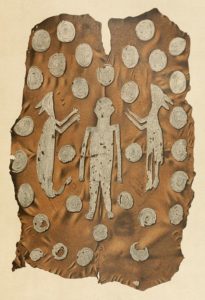The Powhatan were part of a large group of Native American people who spoke Algonquian (al-GOHN-kwin) languages. This language family encompasses tribes from a wide swath of North America, including a massive area spanning northeastern Canada to southern Virginia. Tribes in parts of the Great Lakes and the Great Plains also speak Algonquian languages. The term Powhatan can refer to multiple things, including one specific Native American chief, a river, a political territory, or the chiefdom that inhabited this territory.
The Powhatan chiefdom was a paramount chiefdom, meaning that it was composed of two tiers of chiefs, with Powhatan at the top. The subordinate chiefs sometimes led smaller tribes that had been conquered and absorbed by the confederation. Powhatan was more powerful than any of the other chiefs, reigning throughout the late 1500s and the early 1600s. At its height, the chiefdom was composed of approximately 15,000 people.
One of the most interesting artifacts from this time period is an item called Powhatan’s Mantle. This massive piece of cloth, embroidered with shells, is believed to have been owned by Chief Powhatan. The mantle is made of four deer skins sewn together. The shells form 32 discs surrounding a human figure and a pair of animal figures. It is possible that the discs each represent one of the tributary communities conquered by Powhatan, but we may never know for sure. Archaeologists have hypothesized that the animal figures are wolves or deer. Regardless of its mysteries, this artifact is a beautiful item and a clear testament to Powhatan’s considerable power in 17th-century Virginia.

Kiskiak means “wide land” or “broad place,” which isn’t surprising if you think about the wide stretch of land that Kiskiak covered. Archaeological evidence shows that a large native town developed at Kiskiak between 1200 and 1500 CE, but that there were smaller settlements along Indian Field Creek beginning 8,000 years prior or even earlier.
The Kiskiak were a separate group that were incorporated into the Powhatan chiefdom in the late 16th century through violent conquest. When John Smith encountered the Powhatan in the early 1600s, the chiefdom was still growing. There were about 150 residents at Kiskiak in 1608, based on Smith’s count of how many warriors lived in the community. A werowance, or political leader, also lived at Kiskiak and likely reported to the paramount Chief Powhatan.
One of the best sources of food near Indian Field Creek were the many oysters that lived in this body of water. The Kiskiak ate a lot of oysters, and then threw away the oysters’ shells. While seemingly trivial, this fact has been especially important to archaeologists. Archaeology has uncovered hundreds of these shells and we can learn a lot from studying them about the community’s practices and their ecological surroundings.
Many thanks to Dr. Martin Gallivan, Jessica Jenkins, and the William and Mary Center for Archaeological Research for their knowledge.
Further reading is available in The Powhatan Landscape: An Archeological History of the Algonquian Chesapeake by Martin D. Gallivan